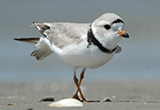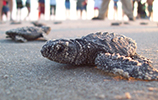FL Shorebird Story
NFWF funds helped Audubon Florida protect hundreds of shorebird nests like the one of this American Oystercatcher. Credit: Stephen Mann

For more than 20 years NFWF has led conservation efforts in the Gulf of Mexico.
Birds and Tourists Sharing the
Shore in Florida
Movies and postcards paint a picture of Florida beaches as sterile strips of white sand mainly populated by sunbathers. Over the years that's the picture some tourists have come to expect and some communities try to deliver.
As a result the wildlife and habitat of Florida's Gulf Coast have been squeezed out by coastal development and sand grooming machines that strip beaches of seaweed and other natural debris birds depend on for nesting and feeding.
When a federal court put NFWF in charge of distributing $100000 in community service fines from a shipping case in 2009 NFWF partnered with Audubon Florida to dedicate the Impact-Directed Environmental Accounts or IDEA funds to protecting the state's vulnerable shorebirds.
"We were able to direct a $100000 grant to Audubon Florida to create a model for beach stewardship to resolve the conflict between human needs and uses of the beach with those of the shorebirds" said Dan Petit director of NFWF's Bird Conservation Initiative.
The impact was immediate.
The NFWF funding allowed Audubon Florida to mark hundreds of shorebird nests across six counties with stakes and string and recruit 175 local residents to serve as "bird ambassadors" during the spring and summer nesting season.
Before the arrival of the bird ambassadors beachgoers often inadvertently frightened nesting birds leaving eggs and newborn chicks exposed to fatally scorching sun or to hungry predators such as crows and gulls.
Only 400 adult Snowy Plovers remain in Florida and other beach nesters like Least Terns Black Skimmers and American Oyster-catchers are listed as threatened species under state law. With numbers like these every newborn chick is critical.
The Audubon citizen-stewards not only protect the nesting sites but educate beachgoers in how to share the shore with birds–often inviting them to peep through scopes at plover chicks that look like white cotton balls balanced on fragile toothpick legs.
"We have made great headway for shorebirds" said Julie Wraithmell Director of Wildlife Conservation for Audubon Florida. "The beach is not a sterile strip of sand ---it's a living system. "
Audubon Florida also works with coastal cities and towns to better protect beach-dependent birds. Many local communities now support marking nesting areas and avoid raking beaches during nesting season.
A study by a local Florida college found an 84 percent reduction in disturbance of posted nesting areas when Audubon bird stewards are present.
"What I like so much about this project is that it shows the human dimension of conservation" said Petit. "You've got everyone from grandparents to grandkids from local communities all out there working to protect birds and educate the public."

New fencing gives sea turtle hatchlings a new lease on life.


